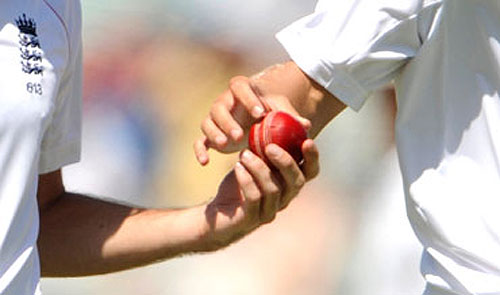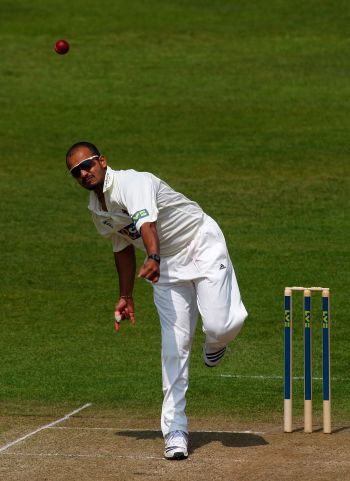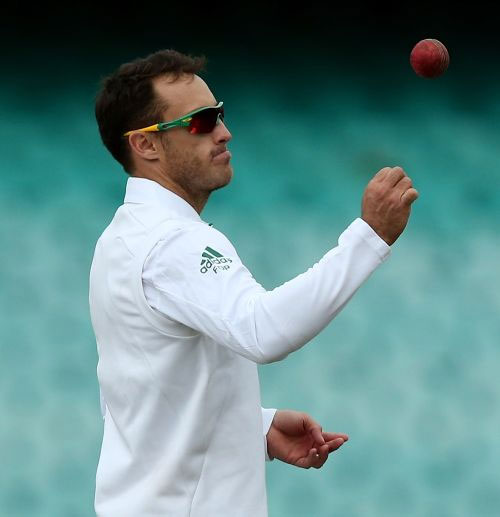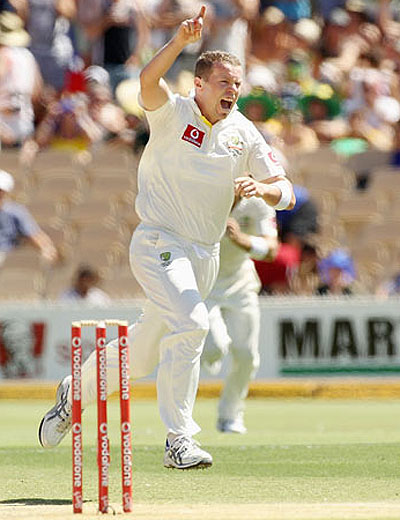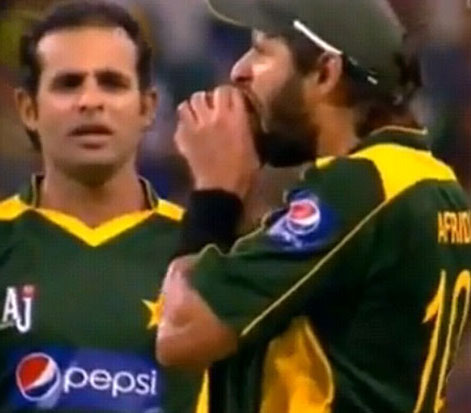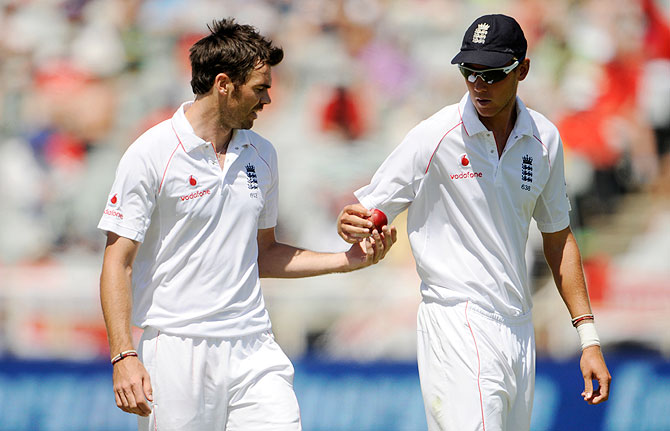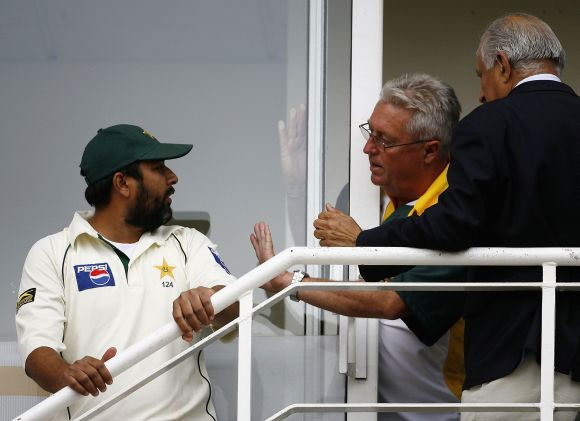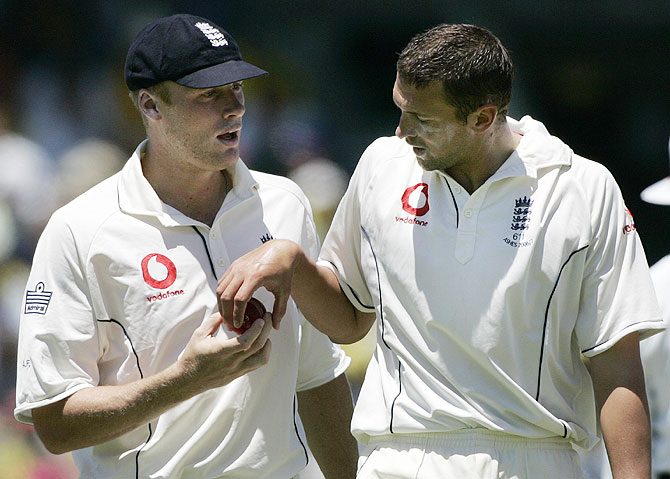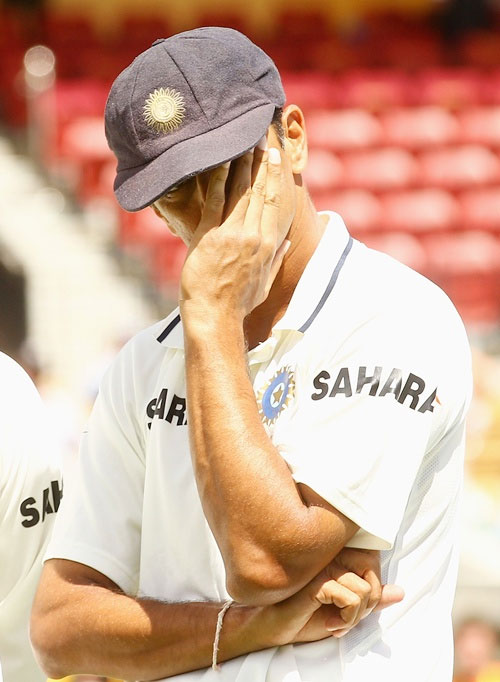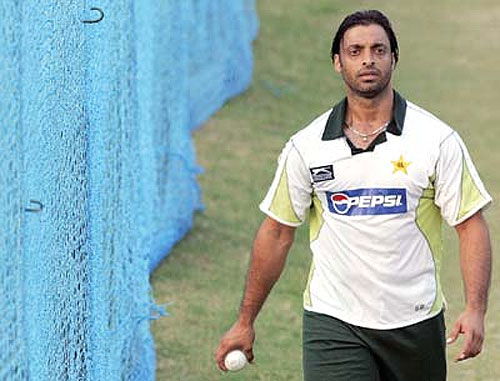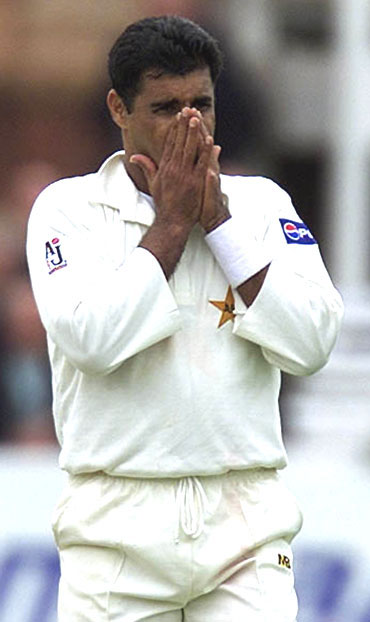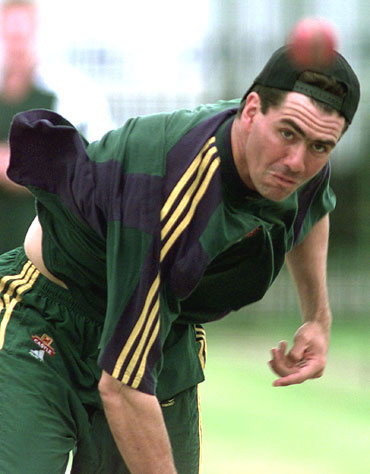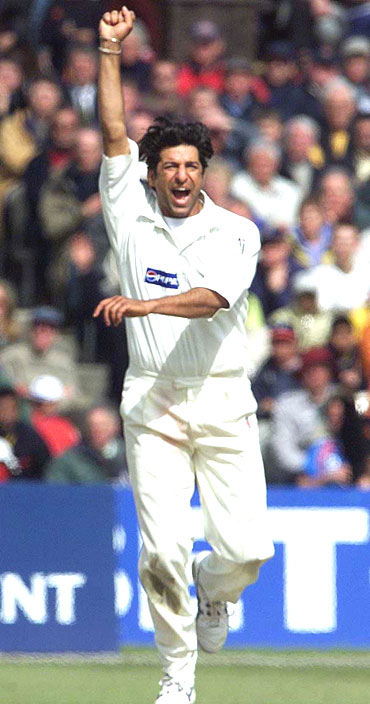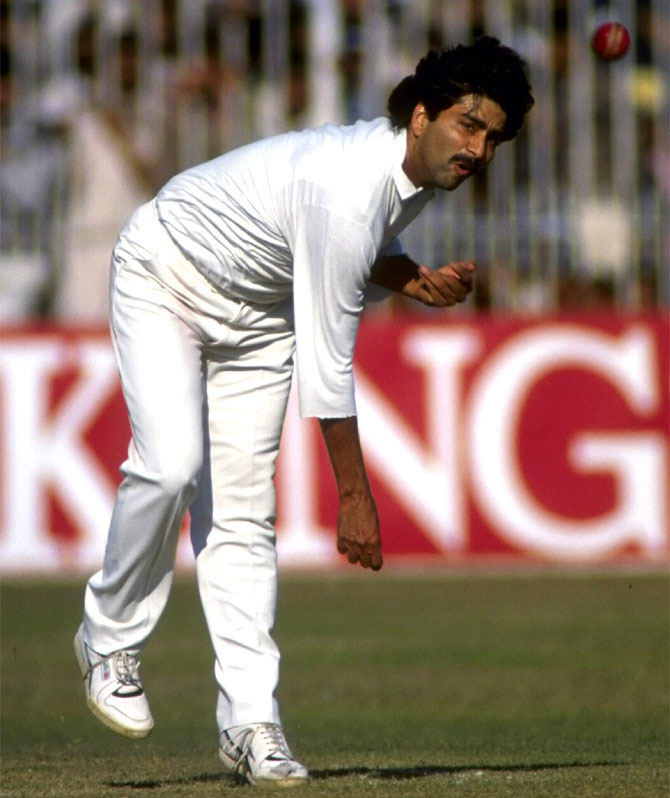 | « Back to article | Print this article |
Ball tampering controversies that tainted the gentleman's game
The ghost has returned to haunt cricket. This time it is not match-fixing, but the other old demon -- ball tampering -- that has cast a cloud over the 'gentleman's game'.
South African batsman Faf du Plessis claimed on Tuesday that something was fishy about the ball reversing so early as Australia gained the upper hand in the decisive third Test, with a 234-run lead at stumps on Day 3.
These fresh claims of tampering come at the back of accusations made by Australia's David Warner against the Proteas during the second Test, which the tourists lost, last week.
"We were actually questioning whether or not (wicketkeeper) AB de Villiers would get the ball in his hand and, with his glove, wipe the rough side every ball," the left-hander told Sky Sports Radio.
The South African management, quite obviously, rubbished the claims.
Following these string of insinuations, Rediff.com presents instances of ball tampering that have clouded the game.
Click NEXT to read more…
Also Read
- Ball tampering incidents in international matches
Ball tampering controversies that tainted the gentleman's game
Veteran spinner and Railways captain Murali Kartik was embroiled in a controversy after he was warned by the umpires for some "issues" with the ball in an acrimonious day three of the Ranji Trophy quarter-final match against Bengal in January.
Match referee Rajendra Jadeja said he received a report from the umpires who changed the ball after warning Kartik.
Bengal team manager Debabrata Das said his side noticed the incident just after lunch when Abhimanyu Easwaran was castled by Anureet Singh for a golden duck in the fifth over by "reverse swing".
Leveling ball tampering charges against Kartik and pacer Anureet Singh, he said, "The ball started reversing from the fourth over which was just impossible. They were pricking the ball and coach Ashok Malhotra and I complained this to the Match Referee."
He further said umpire Suresh Shastri at the high court end warned Kartik and changed the ball at the drinks break in the second session when Bengal were 15 for 2 in 14 overs.
It all started when umpire Shastri ruled out a close caught behind appeal of Subhomoy in the ninth over as Anureet bowled five maiden overs on the trot.
In each delivery, Singh ran up to the batsman and exchanged something, while Kartik also gave a back-up from slips.
Kartik was seen vigorously rubbing the ball on back of his left thigh and apparently shouting something to the batsmen. There was a delay for more than five minutes as both the umpires summoned Kartik and warned him against some "issues" with the ball.
Click NEXT to read more....
Ball tampering controversies that tainted the gentleman's game
Du Plessis might be crying himself hoarse about Australian players indulging in ball tampering in the third Test against Australia, but he is no stranger to controversy.
The South African was fined 50 per cent of his match fee for tampering the ball against Pakistan in the second Test in Dubai in November last year.
He said he was merely trying to shine the ball but admitted that it was a borderline case.
“There are ways of 'working' the ball as much as possible within the rules, such as bouncing the ball on the wicket, trying to bowl cross-seam, and basically trying to scuff the ball as much as possible, naturally, so that it's easier for the bowlers to grip. So, I was trying to keep the ball as dry as possible. As the footage showed, I was on the rough side of the ball, and I'll be the first to admit that I was working it far too close to my zip. That's obviously what the third umpire saw on TV," he had explained.
His antics called for severe criticism, with some saying that he had been let off with a rather light punishment.
Click NEXT to read more....
Ball tampering controversies that tainted the gentleman's game
During the first Test against Sri Lanka at Hobart in December 2012, Australian bowler Peter Siddle found himself at the centre of a row after a picture of him, apparently picking at the seam in Sri Lanka's first innings, circulated on social media.
Siddle had taken nine wickets to help the hosts to a 137-run victory in that Test and Sri Lanka's team manager Charith Senanayake confirmed he had unofficially expressed concerns to match referee Chris Broad.
However, match officials found no evidence of ball-tampering and no charges were laid.
Click NEXT to read more....
Ball tampering controversies that tainted the gentleman's game
It was one of the most bizarre events to have ever been witnessed on the cricket field.
Pakistan’s then captain Shahid Afridi bit into a cricket ball during the fifth and final One-Dayer against Australia in February 2010.
This bizarre instance of ball tampering was broadcast on television and shocked the cricketing world.
The Pakistan all-rounder was banned for two Twenty20 Internationals after pleading guilty to a ball tampering charge but, in his defence, he said all he was trying to do was to “smell the ball”.
Click NEXT to read more....
Ball tampering controversies that tainted the gentleman's game
England’s Stuart Broad paired with bowling partner James Anderson to get himself in a 'sticky' situation.
In January 2010, in a Cape Town Test against South Africa, the duo was accused of ball tampering by rubbing the ball on the ground with their spikes.
Television cameras showed seamer Broad trapping a straight drive with the sole of his boot, football style, and Anderson was pictured working it with his fingers moments later.
This was in the New Year Test versus South Africa.
Broad maintained that he was just being lazy, because it was 40 Celsius in Cape Town that day.
Both pacers denied wrong-doing and escaped an International Cricket Council reprimand, as no charges were formally placed by South Africa even though they made the accusations at a press conference.
Click NEXT to read more....
Ball tampering controversies that tainted the gentleman's game
The controversy, referred to as 'Ovalgate', arose when the umpires, Darrell Hair and Billy Doctrove, ruled that the Pakistani team had been involved in ball tampering.
They awarded five penalty runs to England and a replacement ball was selected by England batsman Paul Collingwood.
Play continued until the tea break, without any Pakistani protest. After the tea break, the Pakistani team, having mutually confirmed that no ball tampering had taken place and given consideration to the severity of the implication, refused to take the field. The umpires then left the field, gave a warning to the Pakistani players, and returned once more 15 minutes later. After waiting two more minutes the umpires removed the bails and declared England winners by forfeiture.
A deal was later brokered between the English and Pakistani cricket boards to allow the match to continue, and the Pakistani team did take to the field 55 minutes after the umpires first took to the field for resumption of play.
Umpires Hair and Doctrove, however, declined to continue the game maintaining their decision that Pakistan had forfeited the match by refusing to play.
When Pakistan later took the field, the umpires did not appear, leading to extensive negotiations that ended with the match being abandoned almost six hours after the drama began.
But in July 2008 the International Cricket Council agreed in principle to alter the result to "match abandoned as a draw" from a forfeited win for Michael Vaughan's men.
However, cricket's ruling body restored the initial result of an England win in February 2009, saying it made the decision after taking legal advice and receiving input from the Marylebone Cricket Club, the custodians of the Laws of Cricket, who said told the ICC it should never have changed the result and that it had set a dangerous precedent.
Click NEXT to read more....
Ball tampering controversies that tainted the gentleman's game
England had mauled Australia 2-1 to win their first Ashes in 19 years in 2005. The victory was spearheaded by their fast bowlers, Simon Jones, Andrew Flintoff (above) and Steve Harmisson, who decimated Australia with reverse swing.
However, in 2008, former England opener Marcus Trescothick made some startling revelations.
Writing in his autobiography Coming Back To Me, he stated that it was his job to shine the ball as best as he could.
He wrote: "It was my job to keep the shine on the new ball for as long as possible with a bit of spit and a lot of polish. Through trial and error I finally settled on the best type of spit for the task at hand.
"It had been common knowledge in county cricket for some time that certain sweets produced saliva which, when applied to the ball for cleaning purposes, enabled it to keep its shine for longer and therefore its swing."
Trescothick continued shining the ball with mint-laden saliva throughout the series and England went 2-1 up before the final Test at the Oval.
The ICC took no note of Trescothick's revelation and everything is status quo.
Click NEXT to read more....
Ball tampering controversies that tainted the gentleman's game
Rahul Dravid’s reputation is clean as a slate but for this one blot on his otherwise spotless career.
Dravid was found guilty of ball tampering during an ODI with Zimbabwe in the Commonwealth Bank Series at the Gabba in Brisbane in 2004.
ICC match referee Clive Lloyd found Dravid guilty of a Level 2 offence and imposed a Level 2 penalty of 50 percent of his match fee for breach of the ICC code of conduct.
The Indian vice-captain was charged under clause 2.10 of the code of conduct, which refers to changing the condition of the ball.
Match referee Lloyd emphasised that television footage conclusively showed the star Indian batsman intentionally applying a lozenge to the ball during the Zimbabwean innings.
Click NEXT to read more....
Ball tampering controversies that tainted the gentleman's game
It was New Zealand versus Pakistan in Dambulla, 2003.
Shoaib Akhtar was banned for two ODIs and fined 75 per cent of his match fee after television cameras caught him scratching the surface of the ball during the Bank Alfalah Cup in Sri Lanka.
Earlier, in November 2002 he was found guilty of ball-tampering during the first Test against Zimbabwe at Harare.
ICC match referee Clive Lloyd said the umpires had reported the matter to him and there was agreement that Shoaib had changed the condition of the ball illegally.
Click NEXT to read more....
Ball tampering controversies that tainted the gentleman's game
In a Test match in Port Elizabeth in 2001, Indian players were in the news.
In a controversial decision, match referee Mike Denness penalised six Indian players at the end of the fourth day of the second Test against South Africa.
Virender Sehwag, S S Das, Harbhajan Singh and Deep Dasgupta were charged with showing dissent and attempting to intimidate the umpire, while skipper Sourav Ganguly was booked for bringing the game into disrepute
But allegations of ball tampering against Sachin Tendulkar resulted in a big row.
Tendulkar was found guilty of ball-tampering and handed down a suspended one-match sentence and fined 75 per cent of his match fee by Denness.
Television cameras picked up images that suggested Tendulkar may have been involved in cleaning the seam of the ball. This can, under some conditions, amount to altering the condition of the ball. The incident escalated as allegations of racism surfaced, resulting in a massive backlash from the Indian public and even parliament.
Further developments led to Denness being barred from entering the venue for the third Test. After a thorough investigation, the International Cricket Council revoked the official status of the match and the ban on Tendulkar.
Click NEXT to read more....
Ball tampering controversies that tainted the gentleman's game
Waqar Younis was the first player to be suspended for a One-day international, by match referee John Reid.
Television images showed him and teammate Azhar Mahmood scratching the ball and lifting the quarter seam in the ODI against South Africa in Sri Lanka.
The pacer was fined 50 per cent of his match fee, and Azhar 30.
Then captain Moin Khan was severely reprimanded for "allowing the spirit of the game to be impaired".
Click NEXT to read more....
Ball tampering controversies that tainted the gentleman's game
Australian players accused South African captain Hansie Cronje of ball-tampering during the Sydney ODI in December 1997.
Cronje was cleared by match referee Cammie Smith.
Later, South African coach Bob Woolmer dismissed the allegation as an Australian ploy to demoralise the visiting team.
Click NEXT to read more....
Ball tampering controversies that tainted the gentleman's game
Mike Atherton was fined 2,000 pounds by the English cricket board but was let off by match referee Peter Burge for the 'dirt in the pocket' incident in the Test against South Africa at Lord's in 1994.
Television footage showed Atherton rubbing something to the ball.
He claimed he rubbed dirt from his pocket to aid grip on the ball.
Click NEXT to read more....
Ball tampering controversies that tainted the gentleman's game
Pakistani bowlers Wasim Akram, Waqar Younis and Aaqib Javed were accused of ball-tampering during the team's tour of England in 1992.
However, no action was taken against these players because of lack of video evidence.
Click NEXT to read more....
Ball tampering controversies that tainted the gentleman's game
New Zealand’s Chris Pringle was the first cricketer to publicly admit to ball tampering.
Having made his Test debut against Pakistan at Karachi in 1990, Pringle took a career-best 11 for 152 in his third Test at Faisalabad.
He, however, stunned everyone by admitting that he had tampered with the ball because he was sure the Pakistan bowlers were doing it.
Click NEXT to read more....
Ball tampering controversies that tainted the gentleman's game
John Lever ran through the Indian batting line-up during England's tour of India in 1976-77.
The way he swung the ball on the docile pitches of Delhi, Kolkata and Madras left everyone amused.
But Bishen Singh Bedi was not convinced. He said Lever had used unfair means to shine the ball. The English paceman's habit of rubbing the ball over his eyebrows every now and then was also noticed. Tests on the cricket ball revealed the presence of a greasy substance. However, the issue was hushed up.
Click NEXT to read more....
Ball tampering controversies that tainted the gentleman's game
Among other instances, Manoj Prabhakar is known to have done what Afridi did two decades earlier. During the Napier Test against New Zealand in 1990, the Indian pacer chomped on the ball, then tried to run his nails and flick the seam to gain some advantage -- read reverse swing.
The incident was not reported in India, and even though it received publicity in New Zealand, no action was taken against Prabhakar and everything was forgotten!
Former England captain Bob Willis accused his fellow countrymen of ball-tampering during the 2013 year's Champions Trophy, an allegation the players vehemently denied.
During the Ramadan Cup domestic one-day cricket tournament in Pakistan, in 2002, six Pakistan players -- Naved Latif, Qaiser Abbas, Yasir Arafat, Sajid Shah, Zahid Saeed and Rao Iftikhar Anjum -- were found guilty of ball tampering. A fine of Rs 3,000 was slapped on each of them.
